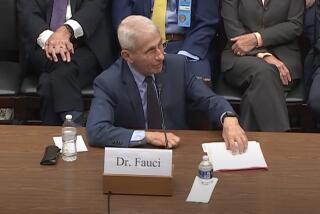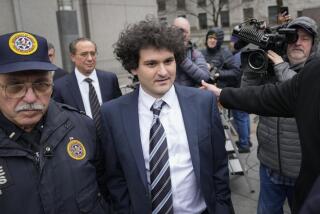Fannie Mae portrayed as villain and victim at hearing on subprime crisis
Reporting from Washington â They were well-intentioned victims of a historic, unanticipated meltdown in the housing market -- or they were reckless, arrogant financial firms that plunged headfirst into the riskiest mortgages in a blind pursuit of profits.
The panel investigating the nationâs long financial crisis heard those two sharply divergent rationales for the failures of mortgage financing giants Fannie Mae and Freddie Mac, which were seized by government officials in 2008 at a cost to taxpayers of $126 billion, to date.
The third day of hearings into the subprime mortgage mess highlighted the difficult task of the Financial Crisis Inquiry Commission in ferreting out the causes of the worst fiscal morass since the Great Depression.
The session was similar to the first two days, in which those at the center of the crisis -- such as former Federal Reserve Chairman Alan Greenspan, top Citigroup Inc. executives and banking regulators -- deflected blame for the huge amounts of subprime mortgages that helped crash the housing market.
On Friday, two former Fannie Mae executives testified that the legislatively mandated mixed mission of the former government-sponsored enterprises -- increase affordable housing and make a profit for shareholders -- drove it so deeply into subprime and other risky mortgages that there was no way out when the real estate bubble burst.
âWe took the brunt of the crisis head on,â said Daniel H. Mudd, who served as Fannie Mae chief executive from 2004 to 2008. âThis extraordinary upheaval in the economy, and in the mortgage market in particular, challenged Fannie Mae in ways that would have been difficult to overcome, regardless of any business decisions that preceded the crisis.â
But two former regulators of Fannie Mae and Freddie Mac testified later that company executives had only themselves to blame as they pursued profits and used aggressive lobbying and campaign contributions to thwart attempts to rein them in.
âUltimately, the companies were not the unwitting victims of an economic down cycle or flawed products and services of theirs,â said Armando Falcon Jr., former head of the Office of Federal Housing Enterprise Oversight, which regulated Fannie and Freddie. âTheir failure was deeply rooted in a culture of arrogance and greed.â
Bill Thomas, the commissionâs vice chairman, said the dueling testimony reminded him of the classic Japanese film âRashomon,â which featured a horrible crime recalled from different points of view.
Thomas, a Republican who represented the Central Valley in Congress for 27 years, told the regulators, âI think your version tends to have a greater degree of credibility . . . than the one that I heard earlier.â
Other panel members also appeared to side more with the regulators. Several were skeptical that Fannie Mae executives acted properly in the years leading up to its failure, when the portfolio of mortgages it owned or guaranteed swelled to more than $3 trillion.
Combined, Fannie and Freddie Mac owned or guaranteed more than $5 trillion in mortgages before they were placed into government conservatorship, with taxpayers taking a 79.9% stake in each company.
âWhat did you do in the presence of this very large risky portfolio . . . to ensure that you didnât end up in the position you ultimately ended up in?â asked Douglas Holtz-Eakin, a Republican appointee to the panel.
Mudd said the company tried to limit its risk. But he admitted that the steps it took werenât enough.
âI want to be clear, I was the CEO of the company and I accept responsibility for everything that happened on my watch,â he said.
But Mudd said his hands were tied because, unlike other businesses, Fannie Mae could not diversify outside of the housing market. As the bubble burst, Fannieâs mandate forced it to dive deeper into the market to offset the departure of other lenders.
But he acknowledged that Fannieâs internal risk projections for the worst-case decline in housing prices during a market crash didnât come close to the huge drop that occurred.
Fannie and Freddie were created by Congress and later turned into private firms that carried an implicit government guarantee. They were required to meet affordable-housing goals -- a set percentage of loans they purchased had to be for low- and moderate-income borrowers. The figure rose from 30% in 1995 to 56% in 2008 as the Clinton and Bush administrations aimed to expand homeownership.
In retrospect, Mudd said, homeownership rates âprobably rose too high.â
The regulators didnât escape criticism. Falcon said he didnât object to the increasing affordable-housing goals.
That prompted the inquiry commissionâs chairman, Phil Angelides, a Democratic appointee and former California state treasurer, to ask if regulators were acting just like many Wall Street executives by failing to fully grasp the scope of the risks Fannie and Freddie were taking.
But there was no consensus on the commission regarding whether Fannie Mae and Freddie Mac triggered the subprime crisis, the subject of a fierce political debate in Congress.
Republicans charge they did by creating a strong demand for risky loans in their desire for profits and to meet housing goals. Democrats argue that the firms contributed to the problems but that the crisis was caused by Wall Street and predatory lenders.
More to Read
Inside the business of entertainment
The Wide Shot brings you news, analysis and insights on everything from streaming wars to production â and what it all means for the future.
You may occasionally receive promotional content from the Los Angeles Times.











